![]()
![]()
![]()
Use LEFT and RIGHT arrow keys to navigate between flashcards;
Use UP and DOWN arrow keys to flip the card;
H to show hint;
A reads text to speech;
51 Cards in this Set
- Front
- Back
|
Constantine and christianity |
313 legalized. 330 state religion. |
|
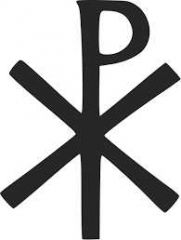
Symbolism |
Chi-Rho: first two letters of Christos. Persecuted sect so only the initiated can understand. Built upon classical world then given christan meaning. Semantic symbols rather than representational. Christian symbolism hidden: fish, anchors of hope and figures of the good Shepard. |
|

|
The Sarcophagus of Junius Bassus. Rome, mid 4th century CE marble 1.2 x 2.4
Different narratives divided by columns. Classically sculpted. No narrative sequence. Christ: now distinguishable between others. Central in composition. clean shaven young man in Greek pallium: philosopher. Apollo. Christianity is state religion. |
|

|
The Good Shepherd, early 5th century CE, mosaic, large, (Italy, located in lunette over the west entrance, Oratory of Galla Placidia, Ravenna, c. 425-426)
Lamb of God. "I am the good shepard". Symbols to represent Christ but the statue is not Christ. Can be viewed as Pan: flute, clean shaven, philosopher clothing. Depth from Roman, spacial recession, framing, |
|
|
4 evangelists |
Mathew: winged man👼 Mark: lion 🦁 Luke: ox 🐂 John: eagle🦅 |
|
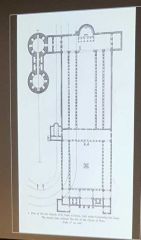
|
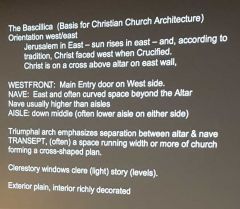
|
|

|
Emperor Justinian and his Attendants & Theodora and her Attendants. Ravenna, mid-6th century CE, mosaic, large , (Italy, Ravenna, apse of Church of San Vitale 2.64 x 3.65m) Posed frontal. Gestures. Illusion of space, feet on top of each other. Gesture of far right man shows they are walking to the right. Elongated figures. |
|
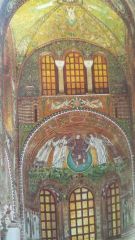
|
Christ Enthroned (St Vitalis & Bishop Ecclesius) Church of St. Vitale, Ravenna mid 6th c Ravenna mid 6th c (outside plain, interior highly decorated with mosaics) Christ Enthroned (St Vitalis & Bishop Ecclesius) Church of St. Vitale, Ravenna mid 6th c (outside plain, interior highly decorated with mosaics)Horror Vacui: fear of empty space. Filled with patterns. Flat plate halo.Mosaic more expensive than painting. Beardless.
Horror Vacui: fear of empty space. Filled with patterns. Flat plate halo. Mosaic more expensive than painting. Beardless. |
|
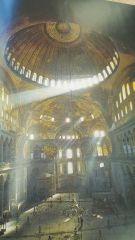
|
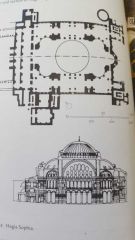
Hagia Sophia, early 6th century CE, gigantic dome on pendentives, imported stone from all over the empire, huge, (Turkey, Istanbul) mathematics/engineering)Mathematics the highest science: physicists, geometry, optics/theoreticians worked together. Interior meant only for the court. Outshine all other religious buildings. Teserae: gold rectangles glued in different angles to reflect light. Large rectangle enclosing a square space. Domes on pillars: pandentine |
|

|
Virgin and child with Saints Theodore and George and Angels, icon. Monastery of St. Catherine, Egypt. 6th C. Encaustic and gold on wood, medium (70 x 50cm)Cathedral of Santa Sophia, (interior) mid-11th century CE, Kiev, UkraineChrist Pantocrator (ruler and judge) 11th C near Athens.
Mary largest and in center. Flat halos. Image of Christ as human a reminder of his sacrifice: more naturalistic icons. Angel heads foreshortened like Hellenistic. Work is made to aid in devotion. |
|
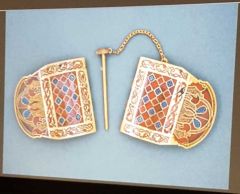
|
Hinged Clasp, Celtic, early-7th century CE , gold cloisonné plaques with granulation and inlays of garnet and millefiore glass, small, (England, Suffolk, from the Sutton Hoo burial, between 601 and 649 , length 12.7 cm) Knotwork: thread used to get never-ending loops correct. Burial site. Biting tails-infinite. Millefiore. Quasinea. Serpentine lines, intricate patterns. |
|
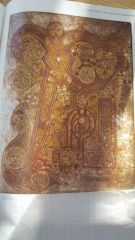
|
Incarnation Initial from Book of Kells, , Celtic, early 9th century, Illuminated Manuscript ox gall inks and pigments on calf-skin vellum, medium, 33 x 25 cm
Carpet page. Parchment:sheep. Calf:vellum. Intricate patterns. Cross faces knots animals "god is in the details" copied: different variations. Hieratic: middle important. Sacred object: word highly important. Insular. |
|
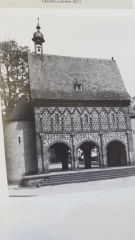
|
Lorsh Gateway Lorsch Germany, façade brick and tiles, 8th C. Equestrian portrait of Charles the Bald(?), 9th century , bronze, small
Charlemagne: Charles Interest is literacy and Latin. Polychrome masonry. Engraded columns and capitals. Triumphant arch. Ionic capitals. Renovatio: |
|
|
Byzantine style |
Gold background (heaven) Gold flat halos Staring straight ahead Somber-worried faces Hierarchical scale Bright colours:mosaic/encaustic Shallow space Easily read symbols Crowd: bunch of heads City: 1 building Angels without bodies Christ in purple robes: philosopher king
|
|
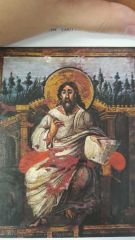
|
St. John the Evangelist, Coronation Gospels late 8th C ink and colours on parchment (vellum) medium .size (32x 25 cm)
Romanesque clothes. central. Still. Somber. Written in gold and silver on purple dyed paper. |
|
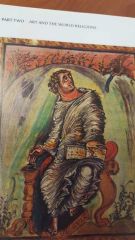
|
St. Mark Evangelist, Ebbo Gospels, late 9th century , colours and ink on vellum, medium size. ( c 875-899 . 25 x 20 cm) Shade and highlighted head, ecstatic expression. Energetic. Spiritual excitement. Nervous energy unprecedented. Gestural. Roman inspired clothes and furniture. Lions. |
|
|
Charlemange |
Emperor crowned by pope. (800 CE) Renivatio: renovation. Learned Latin, never to write. Revised Latin into clear script, Charolingian miniscule. Lorsch gate. Ushered in more illustrative and expressive religious art |
|

|
Doors of Bishop Bernwald, Germany, Hildesheim, early 11th century, cast bronze, huge Easily read programme. Left: old testament. Right: new testament. Figures active, broad gestures, stylized trees like Illuminated manuscripts. Figures compact, elongated, harsher outlines to distinguish minor and major characters. Dramatic expressiveness. |
|
|
Celtic |
Insular or hibero-saxon Interlace knot work. Horror vaccui. Illuminated manuscripts. Decorative arts: jewelry. Scriptorium: rooms in monasteries to write in. Carpet page: highly detailed. Repeated Animal forms. |
|
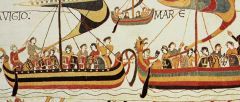
|
Bayeux Tapestry. “The Fleet Sails” detail (Battle of Hastings, 1066) England. Wool embroidery on linen. huge. 50.8 cm high. late 11th C. Commissioned by Bishop Odo (brother of Wm. Conqueror) but Anglo Saxon voice… Made where and Why? Gestural, medival, Romanesque, big hands, active, limited colours, outline sketches.Embroidery. Secular. 1066 conquering of England by France. Historical overview, made afterwards. |
|
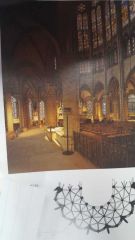
|
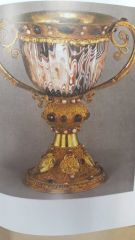
Abbot Suger – Abbey Church of St. Denis,(9:35) mid 12th C. near Paris. Chalice (9:37 in text) (why is this man and this church important?)
Abbot Suger of st. Denis: initiated and directed building. Patron. humbly born but worked his way up to confidant of king. Ambulatory of east hall all that remains. Structural relationships: leads to scholarsticism. Shimmering light is divine light: neophotonic.
Chalice reflects divine light. Relics from patron saint of France. Dead kings. |
|
|
Gothic style |
Pointed gothic arch. Plus anglicannum: English embroidery Rose and Lancet windows: circle and tall thin windows. Flying buttress: supports half arched. Clerestory: Windows in the top section of the walls. Quatrafoil and trefoil: three or four leaves openings for windows Tracery: ornamental stone work over windows Crenelated: battlements. Top of typical castle drawing ya know? |
|
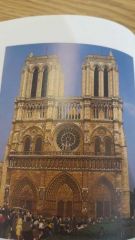
|
Cathedral Notre Dame Paris begun 1163 More glass, less stone. Only 1 spire. Emphasis placed on vertices. Over powers the horizontal facade mirroring the inside. |
|
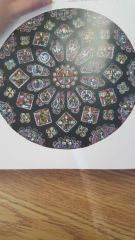
|
North Transept Rose and Lancets, early 13th century, stained and painted glass, huge, (France, Chartres, Cathedral of Notre Dame, gift of Queen Blanche: rich folks like name attached rather than silent donations of the masses.
Cult of the virgin Mary. Virgin and child enthroned. Complex programme. "Bible for the poor and illiterate" divine light. Wanting more windows than wall due to low intensity of stained glass light. |
|
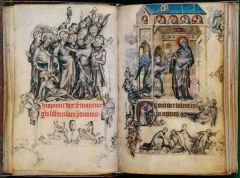
|
Jean Pucelle, Hours of Jeanne d’Evreux, early 14th century , Paris, France. Grisaille and colour on vellum, tiny! (Betrayal and Arrest of Christ, (left) and Annunciation (right), Paris, C. 1325-1328 , 0.08 x 0.06m)Virgin and Child. (Abbey Church of St. Denis) early 14th C. silver gilt and enamel. med (70-cm)
Private patron, personalized to patron saints. Cute daily life scenes added. French artist: trefoil ivy leaves. Grisaille: monichrome. Looks like relief sculpture. let's you know when to pray. |
|
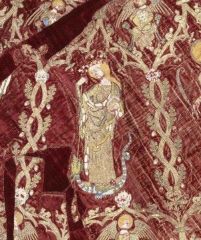
|
“St. Margaret” Butler-Bowden Cope, detail mid-14th C. Red velvet with silk, metallic thread, and seed pearls, green beads, gold rings. Cope is worn - large. 3.45 m wide. Eaten by dragon, cut her way out. Embroidery known as opus anglicanum: English embroidery. Made by man and women inside and outside of the church. Cut up for other garments then reassembled later. Back of priest to the people. |
|
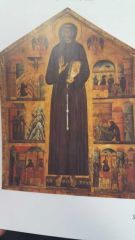
|
Berlingheri, St Francis, mid 13th century , tempera on panel, large (Italy, Pescia, S. Francesco, Byzantine or Maniera Greca, 1235 , about 5 feet x 3 feet) (not shown in text - iconography)
Italian proto renaissance. Gabel frame, gold background, frontal, hierarchy, narratives, gestural. Halo, bible, feet with holes: stigmata: st Francis, belt knotted. Vivid easy to read imagery. |
|

|
Duccio, Virgin and Child Enthroned Maesta Altarpiece, Siena, early 14th century, tempera and gold on wood, huge, (Italy, made for Siena Cathedral 1308-1311, main panel 2.13 x 4.12 m)Duccio, details from MaestaCimabue. Virgin and Child Enthroned, late 13th C, tempera and gold on wood, huge, (Italy, c. 1280. 2.1 x 4m) Giotto. Virgin and Child Enthroned in Majesty early 14th C 10’8” x 6’8” (3.25 x 2m) tempera and gold on panel Sienna: star on virgin. Civic pride. Byzantine style and linear gothic. Signed. Big carved frame. S shaped line. Classical drapery. Bright colours. Ronan and gothic arches. Flat gold halos. Gold back. |
|
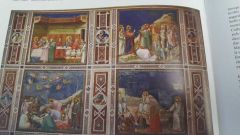
|
Giotto. Arena (Scrovegni) Chapel, near Padua Italy, early 14thC. (3 levels of narration: Anna and Joachim, life of Christ, Passion of Christ) Flat halos. Gold background. Gabel frame. Trefoil and gothic arches. 1) final displacement of Byzantine. 2 established painting as an art form. 3 restoration of naturalistic. Friezes: bands of narrative. Figures with weight. Blue chipping background. Backs of figures. Facial expressions. Humanism. Kiss. Limited colours. Edge of the earth. Light source but no cast shadows. Illusion of space. Foreshortening. |
|
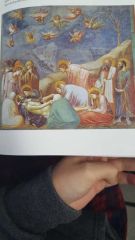
|
Lamentation panel (amongst others), Arena Chapel, Padua. early 14th century , fresco, large, (1305-1306 ) ½ life size see also 0.4 (Nativity fresco divided into working days)•Lorenzetti, Ambrogio. Allegory of Peace. Siena Italy. mid 14th C. Fresco, huge. (1339) Postures and gestures convincingly natural. Natural clothing folds. Direct emotional appeal. Virgin Mary: blue holding son. Mary magedalene: long hair. Nicodemus and Joseph of Arimathea: request to take Jesus down and Shroud for face. Rich clothes. Give tomb. |
|
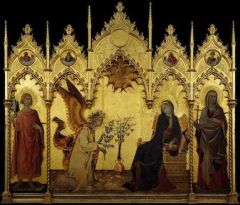
|
Simone Martini The Annunciation Italian International Gothic. early 14th C tempera on wood, large (2.65 x 3.05m 1333 (not in text) Naturalism. Northern and Italian combined. Prophets, dove, empty circle: god by scratched out. Saints by lippo memmi. Ave Maria. Humaistic: figure in book. All vessels: vase for lilies mary for Jesus bible for words. Fancy clothes yo |
|
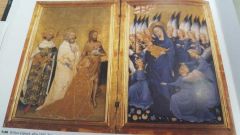
|
Unknown (Eng/French). Wilton Diptych, late 14th C. Tempera and gold leaf on oak small. (ea. 45 x 29 cm)
NORTHERN 2 panels. King Richard being presented to meet with oatron saints. St John the Baptist (lamb), desert dude. Gold and blue expensive. Ermin: white fur black spots. White hart badge deer: kings logo. Skinny baby. |
|

|
Limbourg Brothers. France. “September [or other months]” Tres Riche Heures de Duc de Berry. Early 15th C. ink and colours on parchment. Small illuminated manuscript (22 x 14cm). INTERNATIONAL GOTHIC Duc du berry: wealthy patron. Collector. s curve. Tilted up background. Detailed. Courtly tones. Peasants: comic. Foils for courtly elegance. No reference to religion in art. Book of prayers to be read at certain times. |
|
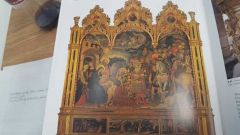
|
Gentile da Fabriano, Italian. Adoration of the Magi, early 15th century, tempera on panel, huge (Italy, Florence, 1423, 3 x 2,82m) INTERNATIONAL GOTHIC predellas. First night scene. Textiles luxiouious. Patrons worked into art. Humanistic. Foreshortening. Lay of Shadow and light. Medical pictorial space. Heads for crowd raised |
|
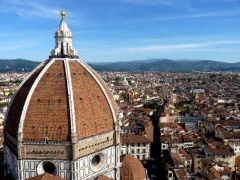
|
Filippo Brunelleschi, Dome of Florence Cathedral, completed late 15th century, interior rings of brick, exterior sandstone ribs and removable terracotta tiles, (Italy, Florence, Santa Maria del Fiore, dome is really an octagonal cupola, completed 1471, exterior dome 54 m tall (13.5 stories), height from drum base to top of dome 33 m tall, diameter wall to wall of the drum that dome sits on is almost 54 m wide)
No centering, technical feat. Oval domes supporting double layered big dome. Solid. Gothic arches.no flyinv buttresses. No stained glass. Small windows. The parts are harmonious with the whole. Two competition panels. The Sacrifice of Isaac. Doors of Florence Cathedral. Filippo Brunelleschi Sacrifice of Isaac and Lorenzo Ghiberti Sacrifice of Isaac. Early 15th C, Bonze with gilding, medium. (1402-02, 53 x 44 cm) |
|
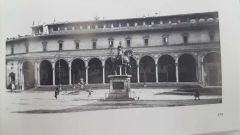
|
15th c Filippo Brunelleschi, Foundling Hospital, Florence. Re-birth of Classical ideals. Early 15th cClassical: Round arches. Columns. Balanced. Dark framing. Human scale. Rectangle windows. Defined stories. Mathematically devised. Distance between arches and to wall. Tondos: baby sculpture on blue Classical: Round arches. Columns. Balanced. Dark framing. Human scale. Rectangle windows. Defined stories. Mathematically devised. Distance between arches and to wall. 15th cClassical: Round arches. Columns. Balanced. Dark framing. Human scale. Rectangle windows. Defined stories. Mathematically devised. Distance between arches and to wall. Tondos: baby sculpture on blue 15th cClassical: Round arches. Columns. Balanced. Dark framing. Human scale. Rectangle windows. Defined stories. Mathematically devised. Distance between arches and to wall. Tondos: baby sculpture on blue 15th cClassical: Round arches. Columns. Balanced. Dark framing. Human scale. Rectangle windows. Defined stories. Mathematically devised. Distance between arches and to wall. Tondos: baby sculpture on blue Tondos: baby sculpture on blue |
|
|
Filippo Brunelleschi |
Florintine. Wealthy family. Metal work. Liberal arts education. Latin. Respected intelligence. Father of geometric perspective "linear perspective. A version of one point perspective. Alberti published it. Baptistry perspective experiment. Mirror. |
|
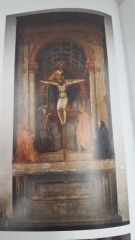
|
Masaccio, Trinity with the Virgin, Saint John the Evangelist and Donors, mid-15th C fresco, huge, (Italy, Florence, c1435-1428 , 6.4 x 3.17m) Morimomento Back tomb can be measured out to make an exact floor plan. Figured to scale. Chiaroscuro. Robust figures. Foreshortening on figures not on god or jesus |
|
|
Stendel |
French writer who fainted at Florentine architecture. |
|
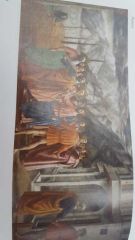
|
Masaccio, Tribute Money. Brancacci Chapel, Florence, early 15th C, huge. Masaccio, Expulsion from Eden. Brancacci Chapel, Florence, early 15th C, hugeMichelozozo di Bartoleomeo (attrib.), Palazzo Medici-Riccardi, Florence. mid 15th C, (Italy, Florence, begun 1446 part of building destroyed, this is a view of the remaining building) Linear perspective. Atmospheric perspective (fuzzy background) middle halo blue beard:Jesus Identifiable landscape. Psychological moral self realization. Weight and volume. Modeled light. Colour theory. Local colours and complimentary colours. Brunelschi system of geometric perspective. |
|
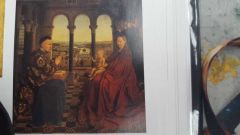
|
Jan Van Eyck, Madonna and Chancellor Rolin. Early 15th C. o/p (oil on panel) medium. (1433-34 66 x 62cm) Northern RENAISSANCE: FLANDERSArchitecture depicts "New Jerusalem" outside. Highly detailed. Naturalistic. Symbolistic: allegory in everyday objects. Recognized in his own time. Architecture depicts "New Jerusalem" outside. Highly detailed. Naturalistic. Symbolistic: allegory in everyday objects. Recognized in his own time. |
|
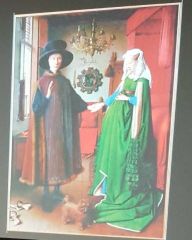
|
Jan Van Eyck, Arnolfini Marriage, early 15th century, o/p, medium, 83.8 x 37.2 cm) NORTHERN RENAISSANCE associated with oil paint. Portraits with limited colour palates. Full body portraits are rare. Fashionable pregnant virgin pose. Use of space. Figures feel large. Textures. Complementary colours. Detail. Symbolism. Wedding. Hope for pregnancy. Witness to marriage. |
|
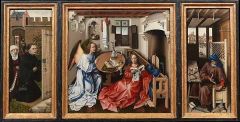
|
Robert Campin, Mérode Altarpiece (Triptych of the Annunciation), Flanders, early 15th century, oil on panel, medium (centre 74. x 63 cm) |
|

|
Rogier Van der Weyden, Flanders, Deposition/Lamentation of Christ, mid-15th century. oil on panel, large, (Belgium, from an altarpiece commissioned before 1443 by the Crossbowmen’s Guild, 2.2 x 2.62 m)Petrus Christus. Flanders, A Goldsmith in his shop. Mid 15th C. o/p (oak), med (98 x 85cm) Hugo van der Goes, Portinari Altarpiece. Three panels. “Nativity” between “The Donors” and their “Patron Saints”. Late 15th C. o/p huge. (text detail 0.5) |
|
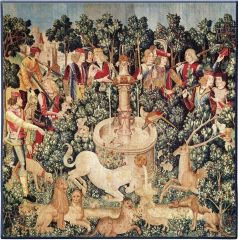
|
The Unicorn is Found, from Hunt of the Unicorn or The Rose Tapestry (text 10:45) tapestry Flanders, 15th century, tapestry, Wool, silk, and metal threads on linen warp, huge, |
|
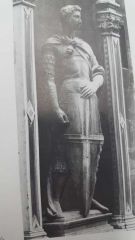
|
Donatello, St. George. Florence, early 15th C. marble. Lifesize, his works include: the ideal, real and psychological)David., mid 15th century, bronze, life size, (Italy, Florence, 1450s or 1460s, 1.58m) Mary Magdalene – wood Appears life size. Set in shallow gothic niche. Guild of armory. Couldn't afford bronze. Made of marble. Contraposto. Knot in clothing. Bold and intense. Furrowed brow. |
|

|
Piero della Franscesca Portraits Battista Sforza and Federico da Montefeltro Urbino, late 15th century, oil on wood panel, small, Italy, Urbino, c. 1474 , each 47 x 33 cm) |
|
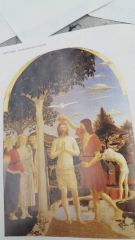
|
Piero della Francesca, Baptism of Christ mid 15th C. Tempera on Panel, Large. Domenico Ghirlandaio. Sassetti Family Chapel. Fresco, late 15th C. Classical and scientific approach to Christian narrative. (Math and important numbers) Theology was regarded as the queen of the sciences. Enhances spirit. Subdued elements. Cool colours, but used tempura. Golden section. Empathetic. Evenly diffused light. Calm. |
|

|
Fra Angelico. Annunciation. Florence. Fresco large, mid 15th C (2.2 x 3.2m) Paolo Uccello, The Battle of San Romano, mid 15th C , tempera on wood panel, large. (not in text) Your text discusses characteristics and focuses on the Flood mid 15th C. Fresco huge.
Dominican friar. Renounce the exorbitant gothic ways of depicting religious icons. Trained in gothicism and miniatures. 1 point perspective but figures aren't placed according to it. Enclosed space. |
|
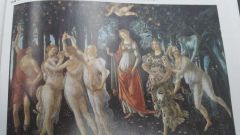
|
Sandro Botticelli, Primavera late 15th C. Florence, tempera on panel. large Secular. Mythology images are acceptable now as stories instead of religious images. Not pagan. Millefois flowers like tapestry. Shallow space. Charming in the magical sense. Medici private collection. No narrative. |
|
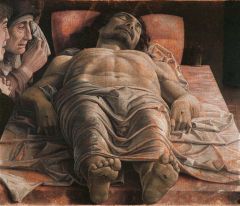
|
Andrea Mantegna. The Dead Chris mid-15th C tempera/ canvas medium. (in text 0.9) Andrea Mantegna. St. Sebastian. mid 15th C. o/p medium.
Artist licence on foreshortening and depth. Perspective used. |

